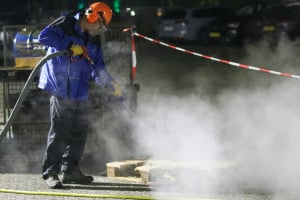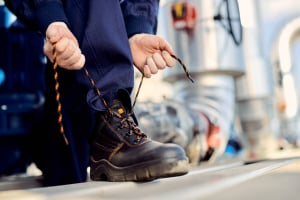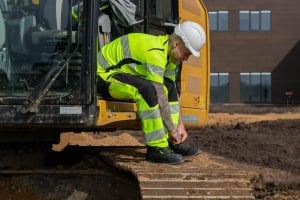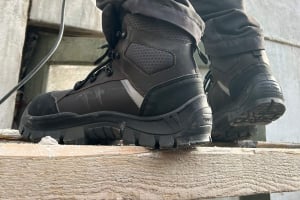
The benefits of a construction helmet with integrated visor
In the construction sector, the Changing safety standards and innovation in personal protective equipment are subjects of constant concern. With the increase in project complexity and associated risks, the adoption of innovative solutions for worker protection has become imperative. Among these innovations, the helmet with integrated visor stands out as a significant advance, promising to improve considerably improves safety on construction sites.
Summary
- The importance of safety on construction sites
- Discovering the helmet with integrated visor
- Enhanced protection
- Comfort and ergonomics: undeniable advantages
- Impact on work efficiency
- Durability and maintenance: practical aspects
- Compliance with safety standards
- Technical innovations and materials
- Buying guide
- Conclusion
The importance of safety on construction sites
Safety on construction sites is a major concern for the construction industry.Accidents are unfortunately common, and their consequences can be extremely serious, even fatal. Statistics reveal that head and facial injuries are among the most common incidents on construction sites, highlighting the need for proper protection. Indeed, a head trauma or facial injury can not only have a devastating impact on the life of the worker concerned, but also result in considerable costs for their employer, in terms of medical care, loss of productivity and compensation.
The safety helmet, a fundamental element of personal protection equipment (PPE), plays a crucial role in preventing these accidents. It is designed to absorb impact energy, protecting the head from serious injury. However, traditional helmets do not cover the face, leaving the eyes, nose and mouth vulnerable to flying particles, chemical splashes and direct impacts.
Discovering the helmet with integrated visor
To fill this gap, innovation has led to the development of helmets with integrated visors. These helmets offer double protection: they protect the head against impacts while securing the face against projected particles and chemical splashes. This integration eliminates the need to wear separate safety glasses, reducing the risk of workers neglecting to wear them or losing them. Additionally, it greatly simplifies personal protective equipment, providing an all-in-one solution that ensures complete coverage and better compliance with safety standards.
The design of these helmets meets a dual objective: to protect effectively and provide optimal visibility without compromising comfort. Visors, often treated against scratches and fogging, ensure clarity of vision in a variety of conditions, while their impact resistance protects against common job site hazards.
Comfort and ergonomics: undeniable advantages
Comfort is essential for prolonged wearing of protective equipment. Helmets with an integrated visor are designed to provide adequate ventilation, reducing sweating and increasing overall comfort. Their customizable fit allows them to be adapted to different head sizes and shapes, ensuringeffective protection and comfort throughout the day.
Impact on work efficiency
These helmets promote greater efficiency on construction sites. By providing complete protection without sacrificing comfort or visibility, they allow workers to fully concentrate on their tasks, improving productivity and reducing interruptions due to equipment adjustments.
Designed to withstand the rigors of construction sites, these helmets combine durability and ease of maintenance. The materials used resist daily wear and harsh outdoor conditions, while the ease of cleaning ensures optimal hygiene and extends the life of the equipment.
Compliance with security standards
Compliance with safety standards is essential for helmets with integrated visors on construction sites. They must meet rigorous international standards to ensure complete protection:
- ISO 3971: For facial protection.
- EN 397: For impact resistance.
- EN 166: For eye protection.
These standards guarantee protection against hazards, with compliance tests that evaluate impact resistance, optical clarity, and durability. Opting for certified helmets minimizes risks and increases safety. Manufacturers' commitment to meeting these standards and employers' responsibility to select certified equipment and train workers in its use are crucial to job site safety.
Technical innovations and materials
Advancements in composite materials and manufacturing technologies have revolutionized hard hats, making them lighter, stronger, and more comfortable. Advanced polymers, such as polycarbonate and ABS, provide excellent impact protection while minimizing weight, reducing user fatigue. Ventilation innovations improve comfort by facilitating air circulation, which is essential for long work days. Customizable adjustments ensure a secure and comfortable fit for various head sizes, emphasizing the commitment to worker safety and well-being.
Buying Guide
Choosing the right construction helmet is essential for effective protection on construction sites. Here are some criteria to consider when selecting:
- Type of Site and Specific Risks: Evaluate the dangers inherent to the project (falling objects, electrical risks, chemical splashes) to choose a helmet adapted to the specific work conditions.
- Comfort and Size: Opt for helmets with adjustment options and good ventilation to ensure comfort during prolonged use.
- Certification: Make sure the helmet is certified by recognized organizations and complies with international safety standards, such as EN 397 for impacts and EN 166 for eye protection.
- Visor Optical Clarity and Impact Resistance: The visor must provide clear vision without distortion and resist impacts and chemicals to ensure effective facial protection.
By taking these aspects into account, you will be able to select a helmet that not only protects effectively but also improves the comfort and productivity of workers on the construction site. Innovations in materials and design play a crucial role in achieving this balance between safety and comfort.
Conclusion
The adoption ofhelmets with integrated visorrepresents a major development in the protection of workers on construction sites. By combining safety, comfort and practicality, these helmets constitute a complete solution to professional risks. Their use not only contributes to the reduction of accidents, but also to the improvement of productivity and the optimization of work performance. With continued advancements in materials and design, the future of jobsite safety looks bright, marked by increased protection and constant innovation.






